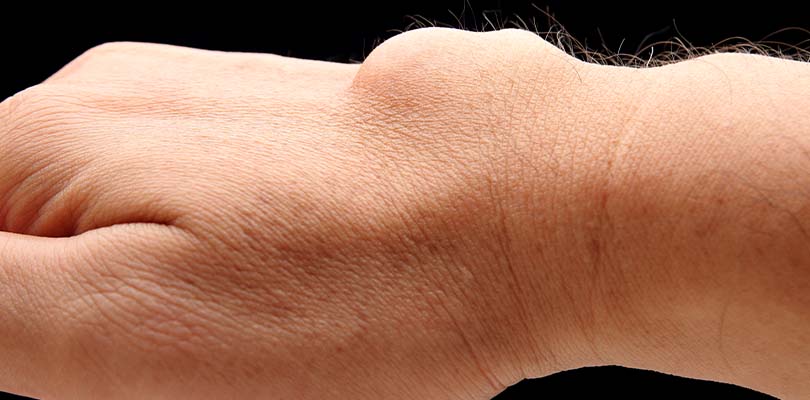What Is a Ganglion Cyst?
Have you ever had a bump on your hand? It could have been a ganglion cyst. What is a ganglion cyst? Ganglion cysts are noncancerous growths that occur along the joints or tendons of the wrist, hand, ankles, or feet. They most commonly occur in the wrists and hand of people between the ages of 15 and 40. While it is not always a painful condition and it is rarely serious, ganglion cysts can be alarming because of their appearance. Read on to learn more about this condition including its causes, symptoms, treatment options and prevention techniques.
What Causes a Ganglion Cyst?
Doctors know very little about ganglion cysts, though they suspect they are caused by leaking synovial (joint) fluid. They have been described in research studies as “enigmatic”. However, there are some suspected risk factors:
- Age and sex. Most ganglion cysts occur in women between the ages of 15 to 40, though ganglion cysts may occur in anybody at any age.
- Joint use. People who exercise certain joints vigorously, like athletes, can more frequently develop ganglion cysts in those joints.
- Injury or trauma. Cysts are more likely to appear in joints that have already been injured and can also form in response to injury.
There is also a pattern to where they form. They usually attach themselves to an underlying joint, most often in a place where a joint or tendon naturally bulges outward.
Symptoms of a Ganglion Cyst
A ganglion cyst is easy to spot because it is a distinctive large lump underneath the skin that has some of the following features:
- The lump may change size
- The lump is soft to the touch but does not move
- Most ganglion cysts cause some amount of pain, though not always severe
- If a cyst is near a tendon, there may be weakness in that finger
Though their appearance can be severe, a ganglion cyst is not a medical emergency. Many people have cysts and experience no other symptoms.
Ganglion cysts are most dangerous when they are near something sensitive like a nerve. A ganglion cyst near a nerve can cause:
- Numbness around the affected area
- Tingling
- Pain, pressure, or discomfort
- Difficulty moving specific joints
A ganglion cyst can usually be diagnosed by eyesight alone. A doctor can shine a light through the cyst to observe the transparency of the fluid inside. The contents of a ganglion cyst should be clear and thick.
In painful cases, an MRI, x-ray, or ultrasound may be warranted to get a better sense of the area around the cyst, as well as to rule out other possible causes of pain.
Before going to your first gynecologist appointment, here are a few things you can expect, how to prepare, and how to stay healthy between visits.
What Are the Treatment Options?
Not all ganglion cysts require immediate treatment. In up to 50% of cases, the cyst disappears on its own. However, cysts may take as long as several years to completely resolve. Many people experience no pain from their cyst. However, they may choose to seek out treatment for cosmetic reasons, since cysts can be quite large and unsightly.
A doctor can help you decide if your cyst requires treatment by whether your cyst causes you pain or not. However, if you are experiencing any pain from your cyst, it is especially important to seek care. Treatment options can vary depending on the case:
- Rest. To encourage the cyst to go away on its own, your doctor may prescribe rest in the affected joint, especially from repetitive movement like typing or playing an instrument.
- Medication. Over-the-counter pain medications like ibuprofen or acetaminophen may be helpful for reducing discomfort.
- Bracing. A wrist brace may also be of benefit in terms of support and restricting movement.
- Aspiration. This is a procedure in which fluid is drained from the cyst. This may relieve discomfort if it is especially large. However, the cyst often forms again.
- Surgery. Surgery can be done traditionally, in which the surgeon makes an incision to remove the cyst. Arthroscopic (keyhole) surgery is also an option. Cysts may return after surgery as well, but not as often as after aspiration.
After surgery, joints need to be splinted for 7 to 10 days and doctors may request a follow-up appointment to make sure the incision is healing correctly and to decide whether physical or occupational therapy is warranted. Aspiration is a much less invasive procedure, so patients can and should move their joints immediately following treatment.
One treatment that has been popular throughout history is hitting ganglion cysts with a blunt object. While it may be tempting to do this, it is not a recommended treatment for this condition. It causes pain at best and at worst could cause a serious injury, especially if the cyst is located near a nerve.
Attempting to drain the cyst is also not recommended, as this often leads to infection and is not often effective at removing the cyst.
Preventing Ganglion Cysts
Unfortunately, it is all but impossible to completely prevent ganglion cysts because their exact cause is unknown. However, they may be correlated with joint stress and repetitive motions, so minimizing these types of actions when possible may reduce the likelihood of developing a cyst. For example, incorporating voice to text or alternative input devices into your computer time to reduce typing.







